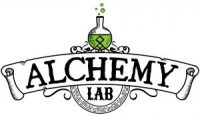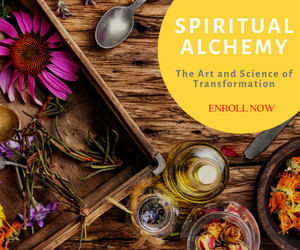The Chemical Arcana
The Great Secrets
The medieval alchemists believed that the Emerald Tablet described the action of seven chemical compounds known to the ancients as the arcana or “great secrets.” The arcana were the divine secrets of creation, the basic archetypes after which all things were patterned. The chemical arcana were the compounds that expressed these eternal truths in the physical world. The properties of these compounds symbolized the highest philosophical truths, as well as demonstrating basic physical principles.
Vitriol
The most important compound, the one in which all other reactions took place, was Vitriol. It was distilled from an oily, green substance that formed naturally from the weathering of sulfur-bearing gravel. After this Green Vitriol was collected, it was heated and broken down into iron compounds and sulfuric acid. The acid was separated out by distillation. The first distillation produced a brown liquid that stunk like rotten eggs, but further distillation yielded a nearly odorless, yellow oil called simply Vitriol. The acid readily dissolves human tissue and is severely corrosive to most metals, although it has no effect on gold. It also shows a tremendous thirst for water. If a flask of Vitriol is allowed to stand open, it absorbs water vapor from the air and overflows its container. The sulfuric acid in Vitriol is the agent of transformation in most alchemical experiments.
Green Vitriol in its natural state is a powerful disinfectant, but the alchemists also made therapeutic use of the iron compounds produced when it was heated. As far back as 1500 BC, Egyptians smelted iron ore and knew its therapeutic value. They used powdered rust (iron oxide) to heal wounds and prepared a tonic from iron sulfate, a by-product of the distillation of Vitriol.
Natron
The Egyptians also accumulated the white salts from dry lakebeds. Known as soda ash (sodium carbonate), the oldest deposits are in the Sinai desert. Another naturally-occurring sodium compound mined by the Egyptians was cubic-saltpeter (sodium nitrate). The alchemists referred to both these salts as Natron (from the Arabic word for soda ash), because they suspected that both had a common elemental basis. To the early alchemists, the word Natron stood for the basic principle in all salt formation and the creation of bodies in general.
Liquor Hepatis
Liquor Hepatis was the name given to another sulfurous liquid used by the alchemists. It was prepared by distilling a solution of sulfur, lime, and sal ammoniac. They secured lime (calcium oxide) by heating limestone and made sal ammoniac (ammonium chloride) by gently heating camel dung in sealed containers. The distillation for Liquor Hepatis produced a combination of hydrogen sulfide and ammonia gases. Since no solids precipitated, alchemists considered this an ascending reaction only. That was a significant fact to the Egyptians, who associated the Liquor with the soul. They believed the soul resided in the liver, and the reddish-brown color of Liquor Hepatis convinced them they had isolated the soul’s essence. The name comes from “hepar,” the Greek word for liver.
The Liquor exuded an unnatural, pungent odor that the alchemists found quite mysterious. They assumed it was due to an ethereal presence concealed in the sulfur and activated by the fertile principle in ammonia. To the Egyptians, the odor symbolized a soul or a spiritized presence hidden within the liquid. They solidified that presence by adding wax and fat to Liquor Hepatis and turning it into a thick paste. The emulsion became known as the Balsam of the Alchemists or Balsam of the Soul. The possibility of coagulating an invisible potential into a second body, like a balsam, became a basic tenet of alchemy.
Pulvis Solaris
If Liquor Hepatis represented soul, then Pulvis Solaris represented spirit. The “Powder of the Sun” was a mixture of two powders, Black Solaris and Red Solaris. Combining black antimony with sulfur auretum made Black Pulvis Solaris. Black antimony was a common sulfide of antimony, now known as stibnite. The mineral was smelted and ground fine. Pure sulfur auretum, or “golden sulfur,” was made by adding sulfuric acid to a dried mixture of sodium carbonate, sulfur, lime, and antimony. The reaction gave off hydrogen sulfide gas, while the sulfur auretum precipitated to the bottom of the container.
Red Pulvis Solaris was made by combining sulfur auretum with a compound of mercury known as red mercuric oxide. Mercury, called quicksilver by the ancients, could be found weeping through cracks in certain rocks or accumulating in small puddles in mountain grottos. It was also obtained by roasting cinnabar (mercury sulfide). The shiny metal would seep from the rocks and drip down into the ashes, from which it was later collected. The early alchemists made red mercuric oxide by heating quicksilver in a solution of nitric acid. The acid, which later alchemists called “aqua fortis,” was made by pouring sulfuric acid over saltpeter. The reaction of quicksilver in nitric acid is impressive. A thick red vapor hovers over the surface and bright red crystals precipitate to the bottom. This striking chemical reaction demonstrated the simultaneous separation of mercury into the Above and the Below.
Mercury
Mercury’s all-encompassing properties were exhibited in other compounds too. If mercury was heated in a long-necked flask, it oxidized into a highly poisonous white powder (white mercuric oxide) and therapeutic red crystals (red mercuric oxide). Calomel (mercury chloride) was a powerful medicine, unless it was directly exposed to light, in which case it became a deadly poison. When mixed with other metals, liquid mercury tended to unite with them and form hardened amalgams. These and other properties convinced alchemists that mercury transcended both the solid and liquid states, both earth and heaven, both life and death. It symbolized Hermes himself, the guide to the Above and Below.
Sulfur auretum showed a strong “love” for either red mercuric oxide or black antimony. As soon as it was mixed with either, they clumped together inseparably. For this reason, alchemists classified Red Pulvis Solaris as a bezoar, which is a hard clump of undigested food or solid ball of hair sometimes found in the intestines. In the Middle Ages, physicians thought the mass protected people from poisons and actually prescribed it to their patients. Egyptian priests discovered bezoars during the preparation of mummies and believed the hard balls were magical pills formed by the large serpent in man (the intestines). Some modern Hermeticists have suggested that the Egyptians also looked for a similar pill in the small serpent in man (the brain) and found it there in the form of the pineal gland. This pine-shaped gland is imbedded with tiny crystals of dark melanin, and could explain the Egyptian pinecone emblems and the origin of the caduceus. It is possible that these two anatomical curiosities became the basis of the alchemists’ preoccupation with the search for the Greater and Lesser Stones in later centuries.
In any case, Egyptian alchemists associated the serpent with the red mercuric oxide and referred to Red Pulvis Solaris as Pulvis Serpentum. In the same way that bezoars were formed in the serpentine contours of the intestines, so was gold formed in the bowels of the earth. Gold was a mineral bezoar. This connection between red mercuric oxide and the formation of gold would convince later alchemists that Red Pulvis Solaris was indeed the powder of projection that would enable them to transform virtually anything into pure gold.
Major and Minor Arcana
The early alchemists divided their chemicals into major and minor arcana. The major arcana consisted of the four compounds: Vitriol, Natron, Liquor Hepatis, and Pulvis Solaris. Three out of the four consisted of dual ingredients that were easily separable. Vitriol could be broken down into sulfuric acid and iron. Natron appeared as sodium carbonate and sodium nitrate. Pulvis Solaris was made up of the red and black varieties. Thus, the seven chemicals comprising the minor arcana were: Sulfuric Acid, Iron Oxide, Sodium Carbonate, Sodium Nitrate, Liquor Hepatis, Red Pulvis Solaris, and Black Pulvis Solaris.
The Arcanum Experiment
The alchemists believed that these secret chemicals could be combined in the Arcanum Experiment, the single laboratory experiment that would demonstrate the archetypal forces and evolution of the universe. Ideally, such an experiment should succeed on many levels, not only corroborating the deepest philosophical and psychological principles, but also providing concrete evidence of their veracity. The Arcanum Experiment should expose the hidden principles connecting heaven and earth, offering a framework in which to explain both microcosmic and macrocosmic events. In order to understand how the Arcanum Experiment proceeds, all we have to do is follow the words of the Emerald Tablet.
Rubric One
In truth, without deceit, certain, and most veritable, the tablet begins. This is not mere hyperbole. On the personal level, “in truth, without deceit” is a promissory preamble that what follows comes from the true heart of its author. Beyond that is the “certain and most veritable” knowledge that can be verified by anyone in this experiment and in all levels of their lives. the tablet begins.This is not mere hyperbole. On the personal level, “in truth, without deceit” is a promissory preamble that what follows comes from the true heart of its author. Beyond that is the “certain and most veritable” knowledge that can be verified by anyone in this experiment and in all levels of their lives.
Rubric Two
That which is Below corresponds to that which is Above. And that which is Above corresponds to that which is Below, to accomplish the miracles of the One Thing. This is the first rubric of the tablet, which introduces the first two compounds used in the Arcanum Experiment. The alchemists described natural phenomena as an interplay of four basic elements: Water (liquids), Earth (solids), Air (gases), and Fire (the temperature of transformation). According to the Jewish alchemists, the first element in creation must be Water and the second must be Earth, as described in Genesis. Greek alchemists were in agreement but based their decision on the so-called Water Transformation Experiment. In this empirical demonstration, standing water evaporates and leaves behind mineral deposits; therefore water contains earth and preceded it. The Egyptian alchemists also agreed, since they felt that the Nile River gave birth to Egypt every year. By the time the Europeans were doing alchemy, the ordering of the first two elements of Water and Earth was well established. Vitriol and Natron were natural compounds, and Water and Earth were the corresponding cosmological archetypes or “givens.” This is the first rubric of the tablet, which introduces the first two compounds used in the Arcanum Experiment. The alchemists described natural phenomena as an interplay of four basic elements: Water (liquids), Earth (solids), Air (gases), and Fire (the temperature of transformation). According to the Jewish alchemists, the first element in creation must be Water and the second must be Earth, as described in Genesis. Greek alchemists were in agreement but based their decision on the so-called Water Transformation Experiment. In this empirical demonstration, standing water evaporates and leaves behind mineral deposits; therefore water contains earth and preceded it. The Egyptian alchemists also agreed, since they felt that the Nile River gave birth to Egypt every year. By the time the Europeans were doing alchemy, the ordering of the first two elements of Water and Earth was well established. Vitriol and Natron were natural compounds, and Water and Earth were the corresponding cosmological archetypes or “givens.”
So, in the Arcanum Experiment, Vitriol was the primary compound and superior element (or Water) and Natron was the secondary, inferior element (or Earth). When the two chemicals are mixed together, Natron settles to the bottom and a slight steaming occurs. The Natron then slowly disperses through the acid (what is Below becomes like that which is Above). In the microcosmic viewpoint of the experiment, Vitriol was Above and Natron was Below, and by their mixture, they served to bring the wonders of this part of the experiment into existence. On a macrocosmic scale, they represented the forces of Water and Earth. On that higher level, they served to bring the wonders of the universe into existence. The final Vitriol-Natron solution was known as the Occult Water and corresponded to the primordial waters of creation.
The first rubric continues: And as all things have come from this One Thing, through the meditation of One Mind, so do all created things originate from this One Thing through Transformation. This is an elaboration of the image of the primordial Occult Water. To the Greeks, the One Thing was the Prima Materia, the First Matter from which all things evolved or transformed. To the Jewish alchemists, the One Thing represented the primal forces gathered by God at the beginning of Genesis. “The meditation of One Mind” was a way of describing the Greek logos, which in Judaism was the creative Word of God.
Rubric Three
Its father is the Sun; its mother the Moon. The Wind carries it in its belly; its nurse is the Earth. The pronoun “it” in these lines from the second rubric refers to the One Thing of the previous paragraph. On the level of the experiment, this might be paraphrased as: “Vitriol is the active Sun or father of the Arcanum, Natron is the passive Moon or its mother. Vitriol is formed by the weathering of rocks, and Natron is mined from the Earth.” The pronoun “it” in these lines from the second rubric refers to the One Thing of the previous paragraph. On the level of the experiment, this might be paraphrased as: “Vitriol is the active Sun or father of the Arcanum, Natron is the passive Moon or its mother. Vitriol is formed by the weathering of rocks, and Natron is mined from the Earth.”
The third rubric continues: It is the origin of All, the consecration of the Universe. Its inherent strength is perfected, if it is turned into Earth. On a macrocosmic level, the One Thing is the origin of all things and its essence is perfected when it is transformed into a material body. On the level of the experiment, this reads: “The active nature of Vitriol is the source of all changes in the experiment; the potential of Natron is achieved when it is transformed into an inert Salt.”
Rubric Four
Now we come to the crucial fourth rubric: Separate the Earth from Fire, the Subtle from the Gross, gently and with great Ingenuity. This rubric describes the mixing of the final pair of arcana, Liquor Hepatis and Pulvis Solaris. Since these are not natural compounds, it is necessary to prepare them in a laboratory using heat. But the early alchemists were in disagreement as to the elemental constitution of these two remaining compounds. In keeping with the ordering of the first rubric, they believed there must be a superior element with a Water component and an inferior element with an Earth component. Obviously, Liquor Hepatis contained the Water element and Pulvis Solaris contained the Earth element. However, it took many years before the Egyptian, Jewish, and Greek alchemists could all agree about which represented Fire and which represented Air. In Alexandria around 50 BC, they finally concurred that the spiritized Liquor Hepatis contained the elements Air and Water, and the reactive Pulvis Solaris contained the elements Fire and Earth.
The alchemists saw in the fourth rubric a formula for what happens when the Pulvis Solaris is added to the Liquor Hepatis. The powder sinks to the bottom and starts bubbling, releasing a warm, red steam. The bubbling action causes the powder to repeatedly rise to the top of the Liquor and then sink back down again. After the reaction is over, a red precipitate accumulates on the bottom. This is a similar process to the creation of the Red Solaris, which is formed by heating mercury in nitric acid. In that reaction, red steam is formed, and red crystals fall to the bottom. Another parallel is the creation of Liquor Hepatis, which is produced by repeated distillations of a dark, sulfurous solution. So, in all reactions involving Pulvis Solaris and Liquor Hepatis, what ascends is a reddish gas, and what descends are red precipitates.
Let us review the instructions in the fourth rubric. “Separate the Earth from Fire” calls for the Earth element to be separated from the Fire element in Pulvis Solaris. “Separate the Subtle from the Gross” calls for the Air (Subtle) element to be separated from the Water (Gross) element in Liquor Hepatis.
The fourth rubric continues: It rises from Earth to Heaven, and descends again to Earth, thereby combining within Itself the powers of both the Above and the Below. On the level of the experiment, this not only describes what happens when the Liquor Hepatis and Pulvis Solaris are mixed together, but also what happens when that mixture is added to the Vitriol and Natron solution prepared earlier. As the mixture of the four arcana is heated, the chemicals begin to react. A white cloud of ammonia forms on the surface of the acid and any solids at the bottom rise to the top and then fall back down again. Further heating causes a red vapor to form, as the precipitated matter releases gases when it reaches the surface. This circulatory pattern continues until the reaction plays itself out.
The constituents of the four major arcana have broken down into the seven minor arcana and recombined to make totally different compounds. By their exchange of elements, Pulvis Solaris and Liquor Hepatis each received the powers of all Four Elements (the powers of the Above and the Below) when they were mixed in a solution of Vitriol and Natron.
Rubric Five
Thus will you obtain the Glory of the Whole Universe. All Obscurity will be clear to you. This is the beginning of the fifth rubric, which brings all levels of the Four Elements of the Four Arcana together in a Fifth Element, the Quintessence. Thus have we obtained the “Glory of the whole Universe” by understanding the operation of the Four Elements on all levels: in this experiment, in nature, in our own minds, and spiritually. The statement that “All Obscurity will be clear to you” points beyond the Four Elements to knowledge of the One, the perfected soul, the Quintessence that rules over all of them.
In fact, a chemical compound corresponding to the Quintessence must have been produced in the Arcanum Experiment for this multi-leveled allegory to be complete. After the final reaction is over, the only thing that remains is a weak solution of sulfuric acid and a variety of sodium compounds. The alchemists believed that the Quintessence was one of these sodium compounds, a “second body” of Natron formed during the experiment. This fifth essence was beyond the Four Elements and exhibited a durability and permanence the other elements lacked. To the alchemists, these inert salts represented a resurrected and incorruptible body.
This perfected body is described in the remainder of the fifth rubric: This is the greatest Force of all powers, because it overcomes every Subtle thing and penetrates every Solid thing. So the fifth rubric refers to the Quintessence of the experiment in both a microcosmic and a macrocosmic sense. It is both the inert Salt and the glorified Body of a perfected soul, which will enable us to be at home in heaven and on earth.
Rubric Six
In this way was the Universe created. From this comes many wondrous Applications, because this is the Pattern. This sixth rubric refers back to the first rubric, which describes the primal separation of the Above and the Below, as well as the separation of compounds in the Arcanum Experiment. As all things originate from One Thing through transformation, so do the wonders of the experiment proceed from the mixing of Vitriol and Natron, which created the Occult Water. “This is the Pattern” refers specifically to the formula of perfection demonstrated in the Arcanum Experiment and in all of nature. This sixth rubric refers back to the first rubric, which describes the primal separation of the Above and the Below, as well as the separation of compounds in the Arcanum Experiment. As all things originate from One Thing through transformation, so do the wonders of the experiment proceed from the mixing of Vitriol and Natron, which created the Occult Water. “This is the Pattern” refers specifically to the formula of perfection demonstrated in the Arcanum Experiment and in all of nature.
Rubric Seven
Therefore am I called the Thrice Greatest Hermes, having all three parts of the wisdom of the Whole Universe. The name mentioned in the seventh and final rubric is that of Hermes Trismegistus, the Egyptian scribe and sage who lived around 2500 BC. He is said to have invented writing and mathematics and was the first alchemist. As a god, he certainly became three-times great: he was associated with the Egyptian god Thoth, the Greek god Hermes, and the Roman god Mercury.
Just as the actions of the alchemical God created three hidden principles in the creation of the universe, later alchemists discovered three hidden principles in the unfolding drama of the Arcanum Experiment. They would name these three philosophical chemicals Mercury, Sulfur, and Salt. This trinity of subtle elements formed the core of alchemical thought for centuries and gave alchemists “all three parts of the wisdom of the Whole Universe.”
Herein have I completely explained the Operation of the Sun. So ends the seventh rubric. The Operation of the Sun is the spiritual unfolding of the universe. It reveals itself in the maturing of metals into gold and also in the perfection of the human soul. The goal of alchemy is to discover the Arcanum, the single substance that will speed-up this process and reveal the Quintessence of man himself — his incorruptible, immortal, golden body. To the alchemist, everything in the universe is part of the divine art of making gold.
Sources
G. R. S. Mead, Thrice Greatest Hermes: Studies in Hellenistic Theosophy and Gnosis, (York Beach, Maine: Samual Weiser, 1992). 864 pages. The best translation of the Corpus Hermeticum, the surviving works of Hermes Trismegistus.
Dr. Gottlieb Latz, Die Alchemie: Die Lehre von den Grossen Geheim-Mitteln der Achemisten und die Speculationen Welche Man an Sie Knupfte, (Bonn, Germany: Selbstverlag, 1869). 600 pages. The translated title is Alchemy: The Study of the Arcanum and How One Can Achieve It.
Dr. Gottlieb Latz, Secret of the Emerald Tablet of Hermes. Translated by D. William Hauck. (Holmes Publishing Group, Box 623, Edmonds, Wash., 98020; 1993.)
Mark Haeffner, The Dictionary of Alchemy, (London, England: The Aquarian Press, a division of HarperCollins; 1991). 272 pages. This compendium is an excellent source for understanding basic alchemical concepts.
Manly P. Hall, Man: Grand Symbol of the Mysteries, (Los Angeles, California: Philosophical Research, 1972). 254 pages. Chapter 16 discusses the Egyptian fascination with the pineal gland.
Rene Guenon, The Great Triad, (Cambridge, England: Quinta Essentia, 1991). 171 pages. This discussion of the three universal principles penetrates all the great spiritual disciplines. Chapter 12 is devoted to the triad of Sulfur, Mercury, and Salt.





